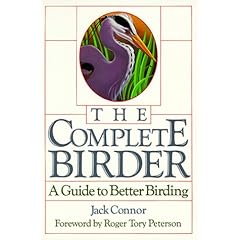Book Review: The Complete Birder
 Birders can argue ad nauseum regarding the "must have" books for any new birder. Aside from preferred field guides, my argument would include several supplemental books. At the top of that supplemental list are Sibley's Birding Basics and Jack Connor's The Complete Birder: A Guide to Better Birding.
Birders can argue ad nauseum regarding the "must have" books for any new birder. Aside from preferred field guides, my argument would include several supplemental books. At the top of that supplemental list are Sibley's Birding Basics and Jack Connor's The Complete Birder: A Guide to Better Birding.
Back when I was a fledgling birder, I bought Connor's book for a whopping $4 from a store that was going out of business. What a steal! I read it from cover to cover, but at that time, I didn't appreciate some of the advanced birding tips the author gave. Over the years, I have repeatedly reviewed the book and have learned new things each time.
The Complete Birder covers a range of topics for the beginning and advanced birder. As a beginning birder, the author introduces topics such as bird biology, migration, optics, weather, and feather molt. Connor's friendly and humorous writing makes these sometimes confusing topics very accessible to a beginner. After introducing birders to the "required topics", Connor highlights birding throughout the seasons. He stresses the importance of knowing what birds to expect when. For example, he talks about Catharus thrushes in the winter and how you are most likely going to see a Hermit Thrush vs. any of the others. He also highlights buteos and terns in a similar manner.
As a birder becomes more advanced, the remaining chapters of the book are extremely beneficial. The common challenges of bird identification are given their own chapters: raptors in flight, shorebirds, terns, gulls, and warblers. Here's where Connor's book really shines. Each chapter breaks down these challenges into smaller, manageable chunks - separating shorebirds into "peeps" and "plumps" and by habitat, small vs. medium vs. large terns, etc. Each chapter also features supplemental charts and keys that can be used to separate problem species. For example, he has a key for separating fall Blackpoll and Bay-breasted Warblers. Using a simple list of "yes/no" questions (color of legs, streaking, presence of "bay" on the flanks), he breaks down this difficult id puzzle into simpler terms. He uses similar aids for separating buteos in flight, sorting through shorebirds, and identifying gulls. Comparing this content to Kaufman's Advanced Birding, the text in Connor's book is less technical and more conversational. It doesn't include as many sketches as Kaufman's book does though. (As an aside: I think both are required books for the advanced birder!)
The Complete Birder is a must read for anyone seriously interested in birding. The content covered helps turn a novice birder into a more advanced birder. Connor's conversational writing and humorous anecdotes make it a difficult book to put down. If I have one complaint about the book, it's that it has a slight northeastern slant due to the author's home territory. This doesn't draw away from the rich content included within.
And the fact that you can get this book for less than $2 used on Amazon is awesome...
Let me know if you've read this book and what you think of it.


8 comments:
I read this book a while ago. The chapters on special identification problems are really useful
I also consider this one a classic.
-I read this book too-It was one of my favorites-I didn't think many other people read it.
A classic indeed. Let me add a plug for another unappreciated essential: Kevin Zimmer's Western Bird Watcher (in its second edition titled Birding the American West). Its general hints and identification discussions are useful no matter where you live.
Rick
Rick,
That's one I haven't read, but I'm familiar with who Kevin is. I'll add it to my reading list post haste.
Larry, I didn't think many other people did either. I don't see it in our NJ Audubon shops (probably because I think it's out of print).
Not only have I read and re-read this book through the years, I talk about it on every bird walk I lead, recommending it to anyone who wants to make that next step as a birder. I still use my old National Geographic field guide, several editions out of date, because of all the notes I transcribed on the plates. Kudos to you for highlighting this book!
Mike
Thanks for the book review. I'll have to go find myself a copy. I recently got a copy of the book "Identify Yourself - The 50 MOst Common Birding Identificantions Challenges" by Bill Thompson and have found it useful. I enjoy your blog.
Vern
I first encountered this book years ago when I was starting the transition from beginner to intermediate-level birder. It was perfect timing. It was an accessible book that helped give me a good foundation to tackle tough identification problems. Now my copy resides mostly on the shelf (it's falling apart from hard use) but I often find myself remembering little tips that I originally found in it. I'm glad I'm not the only one who knows this book! I also second Rick's recommendation of Zimmer's book.
Post a Comment